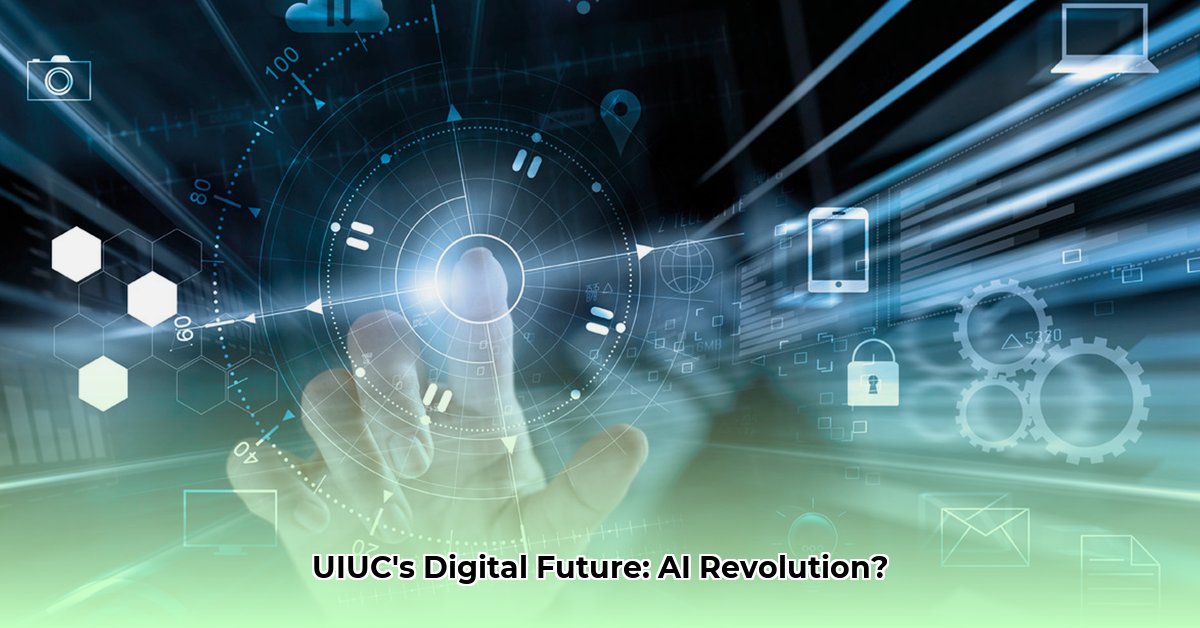Since 1949, the UIUC Digital Computer Lab (DCL) has been a cornerstone of the university’s computing infrastructure. This article explores the DCL’s rich history, current capabilities, and future trajectory, with a particular focus on the integration of generative AI (GenAI) to propel innovation and research.
A Legacy of Innovation: The Historical Evolution of the DCL
The DCL’s story began in 1949, marking a pivotal moment in UIUC’s commitment to technological advancement. A significant expansion in 1963 doubled the lab’s capacity, underscoring the burgeoning importance of computing in research and education. According to the University Library Archives, this expansion included specialized spaces like “tape cutting rooms, offices, conference rooms, and a lab for use with a high-speed computer,” showcasing the forward-thinking approach of the era. This expansion was not merely about space; it was an investment in the future of computation at UIUC, setting the stage for decades of groundbreaking research and development.
Today’s DCL: Functionality and Accessibility
Today, the DCL remains a central hub, providing essential IT resources to the UIUC community. While aggregate usage statistics are not publicly available, the DCL ensures accessibility through strategically located help desks, including those in DCL room L520 and the Illini Union. These support resources are designed to assist students, faculty, and staff with their computing needs, ranging from software troubleshooting to navigating complex research tools. Beyond support staff, the DCL offers a diverse computing environment featuring specialized labs. For example, DCL room L520 offers 38 total seats, with 6 designated as “distraction-reduced seats,” and a study area in the basement, highlighting the DCL’s commitment to providing different learning environments.
Preparing for Tomorrow: Modernization Efforts and Generative AI Integration
UIUC’s 2024-2029 IT strategic plan places significant emphasis on modernization, with generative AI (GenAI) integration as a key priority. This initiative aims to leverage GenAI to enhance personalized learning, accelerate research, and streamline administrative processes. However, this integration also presents challenges, including data security concerns, equitable access considerations, and ethical implications related to AI usage. To address these challenges, the university is focused on implementing robust security measures and establishing clear ethical guidelines. These steps are crucial to ensuring responsible GenAI integration and safeguarding the interests of the entire university community.
Actionable Intelligence: Roadmap for Stakeholders
Successfully transforming the DCL requires a phased, collaborative approach involving all university stakeholders.
Phase 1: Initial Assessment and Targeted Improvements (Year 1)
- Comprehensive Resource Audit: Conduct a detailed inventory of all DCL resources, including software licenses, hardware specifications, and network capabilities. This data will inform future upgrades and ensure optimal resource allocation.
- Specialized Training Programs: Develop and implement training programs for faculty, staff, and students focusing on generative AI (GenAI) tools and best practices. Training should cover practical applications, ethical considerations, and security protocols.
- Enhanced Security Protocols: Implement multi-factor authentication, intrusion detection systems, and regular security audits to protect sensitive data from cyber threats. Ensure compliance with data privacy regulations, such as FERPA and GDPR.
Phase 2: Long-Term Integration and Optimization (Years 2-5)
- Scalable Infrastructure Upgrade Plan: Develop a detailed, scalable plan to upgrade the DCL’s core infrastructure, including hardware, software, and network improvements. This plan should anticipate future demands and incorporate emerging technologies.
- Seamless AI Integration: Integrate generative AI (GenAI) tools seamlessly into DCL services, ensuring equitable access and resources for all users. Develop APIs and software integrations to facilitate easy access to AI tools from various applications.
- Establish Key Performance Indicators (KPIs): Define and track KPIs to measure the effectiveness of DCL services, allowing for continuous improvements and adjustments based on performance data. Include metrics such as user satisfaction, uptime, and the impact of AI tools on research output.
Here’s an outline of actionable steps tailored to specific stakeholder groups:
| Stakeholder | Short-Term Actions | Long-Term Actions |
|---|---|---|
| University IT Department | Conduct comprehensive resource audit; create and deploy AI training programs; enhance security protocols; establish communication channels for feedback. | Oversee infrastructure upgrades; guide generative AI integration; establish and monitor KPIs to measure success; foster collaboration with other departments; develop long-term funding strategies; provide ongoing support and maintenance for all DCL resources. |
| Students | Participate actively in AI training sessions; provide constructive feedback on DCL services; advocate for specific resource needs. | Access advanced computing resources; participate in shaping the future direction of the DCL by providing ongoing feedback; collaborate with faculty on research projects; develop innovative applications using DCL resources; contribute to the DCL’s user documentation and support materials. |
| Faculty | Participate in training workshops to learn about AI tools; explore innovative applications of AI in research; provide feedback on DCL services. | Integrate AI into research projects; provide essential input on resource allocation and specific needs of research programs; collaborate with the IT department on infrastructure upgrades; mentor students in the use of DCL resources; develop innovative teaching methods using AI tools; contribute to the DCL’s strategic planning. |
Conclusion: The Future of UIUC’s DCL
The DCL is more than just a collection of computers; it’s a dynamic ecosystem supporting research, education, and innovation at UIUC. By strategically modernizing the DCL and thoughtfully integrating AI, the university can ensure its continued leadership in technology and learning. This requires a collaborative, proactive, and well-planned effort involving all stakeholders. The future success of the DCL depends on this collective commitment.
Effectively Integrating Generative AI (GenAI) into University IT Infrastructure
Generative AI (GenAI) offers transformative potential for higher education, with the ability to improve learning outcomes, enhance administrative efficiency, and accelerate research capabilities. However, realizing this potential requires a comprehensive strategic approach that addresses data privacy, security, ethical considerations, and stakeholder engagement.
Navigating Opportunities and Challenges
The rapid advancement of generative AI (GenAI) presents both opportunities and challenges for higher education. GenAI tools, such as ChatGPT, are becoming increasingly integrated into widely-used platforms like Microsoft 365 and Google Workspace. While this integration offers convenient access, it also raises concerns about uncontrolled deployment and potential misuse. Institutions must proactively manage these technologies to maximize their benefits while mitigating risks.
Key Integration Steps
Integrating generative AI (GenAI) into a university’s IT infrastructure requires a systematic, multi-step approach:
- Develop a Comprehensive Strategy: Create a detailed plan that explicitly addresses data privacy, security, ethical considerations, and pedagogical implications. This plan should be developed in collaboration with all stakeholders, including faculty, students, IT staff, and administrators.
- Implement Pilot Projects: Begin with small-scale pilot projects to test the integration of GenAI tools in specific areas, such as tutoring, writing assistance, or research support. These projects allow for controlled experimentation, the collection of valuable feedback, and iterative improvements to refine the implementation process.
- Provide Faculty Training and Development: Equip instructors with the necessary skills and knowledge to effectively use GenAI tools in their teaching. Training should focus on responsible use, bias detection, pedagogical best practices, and strategies for integrating AI into the curriculum.
- Implement Data Security and Privacy Measures: Implement robust security measures to protect sensitive student data and ensure strict adherence to FERPA and other relevant regulations. These measures should include secure data storage, access controls, data encryption, and clear data usage policies.
- Establish Ethical Guidelines: Develop a clear set of ethical guidelines for the use of GenAI in teaching, research, and administration. These guidelines should address concerns regarding plagiarism, bias, the potential impact on critical thinking skills, and the responsible use of AI-generated content.
- Conduct Ongoing Evaluation and Monitoring: Continuously monitor and evaluate the impact of GenAI on learning outcomes, teaching practices, and administrative efficiency. This iterative process allows for ongoing improvements and adjustments based on performance data and user feedback.
- Ensure Equitable Access: Ensure equitable access to AI tools and resources across the university, addressing potential disparities based on location, socioeconomic status, or other factors. This may involve providing access to computing resources, internet connectivity, and training programs for all students.
Mitigating Risks
| Feature | Advantages | Disadvantages | Mitigation Strategies |
|---|---|---|---|
| Personalized Learning | Tailored experiences, improved engagement, better retention; addresses diverse learning styles. | Potential for bias, over-reliance on tech, equity concerns; requires careful data management. | Rigorous testing for bias; development of diverse datasets; focus on human interaction; regular evaluation of learning outcomes across all demographic groups; provide alternative learning methods when needed. |
| Automated Administration | Streamlined workflows, reduced administrative burden, increased efficiency; |
- Uncover Timeless Ancient Greece Female Names: A Guide to Choosing the Perfect Name - August 9, 2025
- Explore Ancient Greece Artifacts: Unveiling Iconic Treasures - August 9, 2025
- Unveiling Ancient Greek Marriage: Customs & Laws Revealed - August 9, 2025
















